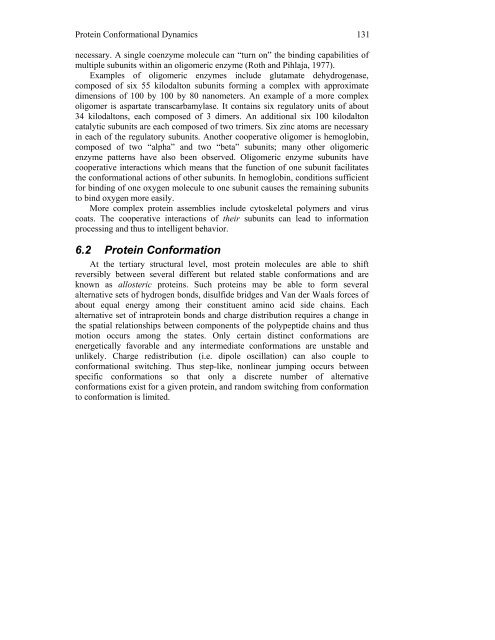ULTIMATE COMPUTING - Quantum Consciousness Studies
ULTIMATE COMPUTING - Quantum Consciousness Studies
ULTIMATE COMPUTING - Quantum Consciousness Studies
- No tags were found...
You also want an ePaper? Increase the reach of your titles
YUMPU automatically turns print PDFs into web optimized ePapers that Google loves.
Protein Conformational Dynamics 131<br />
necessary. A single coenzyme molecule can “turn on” the binding capabilities of<br />
multiple subunits within an oligomeric enzyme (Roth and Pihlaja, 1977).<br />
Examples of oligomeric enzymes include glutamate dehydrogenase,<br />
composed of six 55 kilodalton subunits forming a complex with approximate<br />
dimensions of 100 by 100 by 80 nanometers. An example of a more complex<br />
oligomer is aspartate transcarbamylase. It contains six regulatory units of about<br />
34 kilodaltons, each composed of 3 dimers. An additional six 100 kilodalton<br />
catalytic subunits are each composed of two trimers. Six zinc atoms are necessary<br />
in each of the regulatory subunits. Another cooperative oligomer is hemoglobin,<br />
composed of two “alpha” and two “beta” subunits; many other oligomeric<br />
enzyme patterns have also been observed. Oligomeric enzyme subunits have<br />
cooperative interactions which means that the function of one subunit facilitates<br />
the conformational actions of other subunits. In hemoglobin, conditions sufficient<br />
for binding of one oxygen molecule to one subunit causes the remaining subunits<br />
to bind oxygen more easily.<br />
More complex protein assemblies include cytoskeletal polymers and virus<br />
coats. The cooperative interactions of their subunits can lead to information<br />
processing and thus to intelligent behavior.<br />
6.2 Protein Conformation<br />
At the tertiary structural level, most protein molecules are able to shift<br />
reversibly between several different but related stable conformations and are<br />
known as allosteric proteins. Such proteins may be able to form several<br />
alternative sets of hydrogen bonds, disulfide bridges and Van der Waals forces of<br />
about equal energy among their constituent amino acid side chains. Each<br />
alternative set of intraprotein bonds and charge distribution requires a change in<br />
the spatial relationships between components of the polypeptide chains and thus<br />
motion occurs among the states. Only certain distinct conformations are<br />
energetically favorable and any intermediate conformations are unstable and<br />
unlikely. Charge redistribution (i.e. dipole oscillation) can also couple to<br />
conformational switching. Thus step-like, nonlinear jumping occurs between<br />
specific conformations so that only a discrete number of alternative<br />
conformations exist for a given protein, and random switching from conformation<br />
to conformation is limited.






